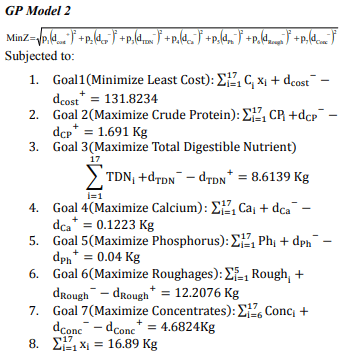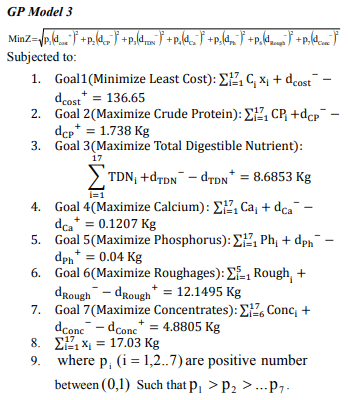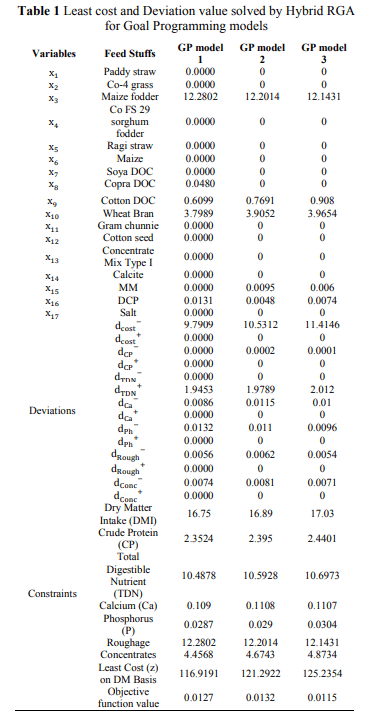A Goal Programming Approach to Ration Formulation Problem for Indian Dairy Cows
Due to limitation of feedstuffs in Mandya, district of Karnataka, small dairy farmers faced many problems to feed balanced, least cost diet to dairy cattle’s. From earlier research, it was clear that the productivity of cattle’s maintained by different dairy farmers was lower and this is mainly due to limited resources for feeding and small farmers are not having proper knowledge as well as resources to provide low cost balanced ration to cattle’s. Therefore, there is a need to focus on minimizing the diet cost by upgrading the scientific dairy farming practices. However, several techniques are in use for animal diet formulation but a successful application of soft computing technique to improve the quality of the solution is always preferred as the rigidity of the functions in Linear Programming Problem (LPP) can be easily handled. Hence, to meet the nutrient requirement,a Primitive Goal programming model for three category of dairy cattle’s weighing 500kg each and yielding 10lit of milk with 4% fat content during 7th, 8th and 9th month of pregnancy is been formulated by dividing the goals into set of priorities. In our earlier work [10], LP models for three categories of dairy cattle’s have been formulated and solved by Simplex-method, GRG Nonlinear, EA-method and RGA. In the present work, a goal programming model (GP model) has been developed by dividing each goal into set of priorities for all the three categories of animal as there are two high priority objectives i.e. least cost and dry matter intake, to be achieved if possible. This GP model is solved by real coded genetic algorithm with hybrid function, which shows that five goals are overachieved whereas one goal is fully achieved and one is underachieved for Cattle 1& 2. It could be concluded that real coded genetic algorithm (RGA) with hybrid function can effectively be used to formulate least cost diet such that the feed requirements of the animals are met without any nutrients deficiency.
Key words: Dairy feed, least cost, real coded genetic algorithm, Goal Programming
- To determine the diet plan the cost will be Rs 126.71for cattle-1, Rs 131.82 for cattle-2 and Rs 136.65 for cattle- 3.
- To determine the diet plan total dry matter (DM) intake will be 16.75 kg for cattle-1, 16.89 for cattle-2 and 17.03 for cattle-3.
- To determine the diet plan the share of Crude protein (CP) will be 1.644 kg for cattle 1, 1.691kg for cattle 2 and 1.738 kg for cattle 3.
- To determine the diet plan the share of Total Digestible Nutrients (TDN) will be 8.5425 kg for cattle 1, 8.6139 kg for cattle 2 and 8.6853 for cattle 3.
- To determine the diet plan the share of Calcium (Ca) will be 0.1176 kg for cattle 1, 0.1223 kg for cattle 2 and 0.1207 kg for cattle 3.
- To determine the diet plan the share of phosphorus will be 0.04193 kg for cattle 1, 0.04 for cattle 2 and 3.
- To determine the diet plan the share of roughage will be 12.2858 kg for cattle 1, 12.2076 kg for cattle 2 and 12.1495 kg for cattle 3.
- To determine the diet plan the share of concentrates will be 4.4642 kg for cattle 1, 4.6824 kg for cattle 2 and 4.8805 kg for cattle 3.




RESULTS AND DISCUSSION
- Annual Report 2016-17., Department of Animal Husbandry, Dairying and Fisheries, Ministry of Agriculture and Farmers.
- Angadi, U. B., Anandan, S., Gowda, N. K. S., Rajendran, D., Devi, L., Elangovan, A. V. and Jash, S. (2016) “ Feed Assist”- An Expert System on Balanced Feeding for Dairy Animals", AGRIS on-line Papers in Economics and Informatics, Vol. 8, No. 3, Pp. 3 - 12. ISSN 1804-1930, DOI 10.7160/aol.2016.080301
- A. R. Rehman, Evolutionary algorithms with average crossover and power heuristics for aquaculture diet formulation [Ph.D. thesis], University Utara Malaysia, Sintok, Malaysia, 2014.
- Basic Animal Husbandry & Fisheries Statistics 2017, AHS Series-18, Government of India Ministry of Agriculture & Farmers Welfare Department Of Animal Husbandry, Dairying And Fisheries Krishi Bhavan, New Delhi.
- FAO. 2012. Balanced feeding for improving livestock productivity - Increase in milk production and nutrient use efficiency and decrease in methane emission, by M.R. Garg. FAO Animal Production and Health Paper No. 173. Rome, Italy.
- Leng, R.A., 1991. Feeding strategies for improving milk production of dairy animals managed by small-farmers in the tropics. Feeding dairy cows in the tropics. (Eds. Speedy, A. & Sansoucy, R.) Proceedings of the FAO Expert Consultation held in Bangkok, Thailand, p.82.
- M. Koda, “Chaos search in Fourier amplitude sensitivity test version,” Journal of Information and Communication Technology, vol. 11, pp. 1-16, 2012.
- M. A. Sahman, M. Çunkas, S. Inal, F. Inal, B. Coskun, and U. Taskiran, “Cost optimization of feed mixes by genetic algorithms,” Advances in Engineering Software, vol. 40, no. 10, pp. 965-974, 2009.
- Rehman, T. and Romero, C. 1984. Multiple-criteria decision-making techniques and their role in livestock ration formulation. Agri. Sys.15, Pp.23-49.
- Ravinder Singh Kuntal, Radha Gupta, Duraisamy Rajendran and Vishal Patil, 2016. Application of real coded genetic algorithm (RGA) to find least cost feedstuffs for dairy cattle during pregnancy. Asian J. Anim. Vet. Adv., 11: 594-607.
- Radha Gupta, Ravinder Singh Kuntal, Kokila Ramesh, 2013. Heuristic Approach to Goal Programming Problem for Animal Ration Formulation. International Journal of Engineering and Innovative Technology (IJEIT), Volume 3, Issue 4, Pp. 414-422.
- Shilpa, Jain, Dinesh, Bisht and Prakash, C,. 2013(3). Comparative Analysis of Real and Binary Coded Genetic Algorithm for Fuzzy Time Series Prediction. International Journal of Education and Information Sciences, 299-304.
- ZoranBabic., Tunjo Peric.(2011) optimization of livestock feed blend by use of goal Programming”, Int. J.Production Economics, 130, Pp.218-223.
- 19 Livestock Census-2012 All India Report Ministry of Agriculture Department Of Animal Husbandry, dairying and fisheries Krishi Bhavan, New Delhi
Using byproducts as a portion is fine but feeding best available ingredients will always yield best performance milk is only one of the aspects you feed for animal well being and additional lactation will only come from quality diets you can't get them bred.
Good Study on the linear program for ration formulation. Yes, it is the basic approach for right calculation as per the mathematical model, Appreciate efforts from Liner Programming point of view.
From practical aspect, few queries for clarity on the mentioned subject,
1. Selection of the late lactating animals ( Span 6-9 months), for higher intake of the Dry Matter, for 10 Ltr. milk DM ( Range 16-17 Kg).
2. The targeted CP in rage of 10 %? and TND @ 51 %, are we targeting too low from nutrient point of view especially if we consider it for Steamers in 8-9 months?
3. Qualification of 6 out of 7 parameters, which have Ca and P also in consideration, may not lead to the right conclusion for practical adoption of the suggested concept.
I trust, it is important to look into the parameters like MP, NE and DCAD for final month i.e. 9 months and its spill over in the fresh period. Further, it may give good idea if Fresh and Early lactation animals are put in the consideration to extend this study beyond Dry Period. This will certainly beneficial for the average Dairy Farmer in South Asia to look at the possible solution when forage is limited and compound is relatively expensive.
Best Regards,
Yes, sir, you are right but corn cub is not available everywhere in India, I check once... Thanks for suggestions.
Sustainable feed formulation prepared from crop residues is the main target. Such formulations are cheaper and it helps to utilize crops residues in most efficient ways. In the article, experiments are based on residues available in a specific area of India while many more useful crop residues are also available and cheaply available in other areas of India as well as in the world. In Pakistan, corn cob is easily and cheaply available in Punjab Pakistan. I use the same as Corn cob meal where I use corn cob 30% while remaining 70% ingredients help in making the concentrate as balanced diet required full nutritional profile required for the animals.
Thank you, Sir. Looking forward to work with untouched field in animal nutrition. Please suggest if any.








.jpg&w=3840&q=75)







.jpg&w=3840&q=75)